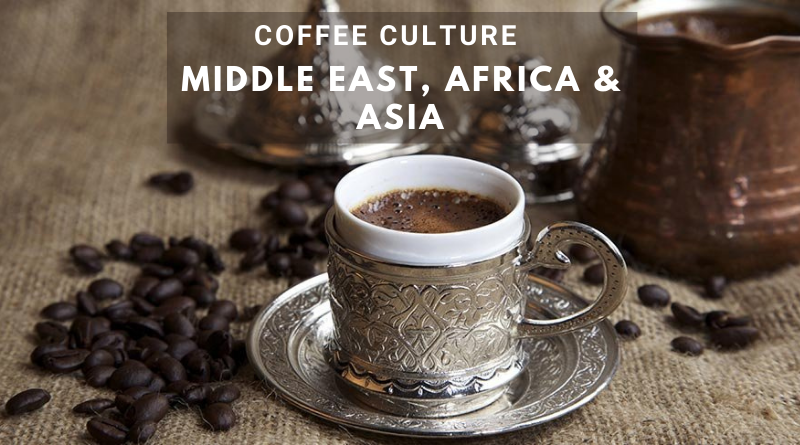Coffee Culture In The Middle East, Africa, and Asia
Western countries have a sophisticated coffee culture. Different countries have cultivated different coffee cultures, and all are unique. The word coffee culture reflects the lifestyle of the people. Like the great western coffee culture, the other parts of the world are also trying to form their own coffee culture. Let’s have a look:
Middle East Coffee Culture
The middle east coffee culture started with the growing popularity of coffee. By the 15th century, coffee started to get famous in the Yemeni district of Arabia. And it took hundreds of more years to earn its popularity in countries like Egypt, Turkey, Persia, and Syria. At that time, people usually have coffee in the houses, or sometimes they went to the coffee houses.
Soon coffee-culture in the middle east started to catch a height, with the coffee houses becoming the centers of various cultural activity. People from all classes gathered around the coffee houses to enjoy coffees, listen to music, exchange thoughts, discussed various news. Thus, the coffee houses started to become famous and came to be known as the schools of the wise.
In the Arabian cafes, different kinds of debates took place that may be on politics or the name of coffee. The culture related to coffee in the Middle East didn’t allow to order Turkish coffee in Greece. They would start a debate on the word that it needed to be called Greek Coffee. Whereas in Lebanon, a glass of Turkish coffee should be called Arabic coffee.
The first café was started in Istanbul in the mid-16th century. However, coffee was banned until 1839 at the Ottoman court during the Ottoman reign.
The culture of coffee in the middle east is symbolic of hospitality, class, and broad nature. Any deals, occasions like marriages, and even conflicts can be fixed over relishing a coffee cup together. In Iran, alcohol is not allowed, and coffee is the best option for the people living there. In some parts of middle east countries, offering a cup of indicates the wish to develop personal bonding, talking about the wellbeing of both, setting some trade contracts, or enjoy quality time. In some parts, the coffee is offered to the head of the family before serving it to the guests to ensure the best quality. Coffee is now an essential part of the middle east, and the middle east coffee-culture is also increasing.
The coffee-drinking culture in the middle east part began almost with the western region, but it can’t reach the height as fast as the western world. Therefore, the coffee-culture in the middle east still lagged behind the western coffee culture.
The African Coffee Culture
Despite providing nearly 13% of coffee beans for the world, the people of Africa lagged in consuming coffee than other parts of the world. The maximum produced coffee there goes in exporting. The coffee-drinking culture in Africa was a little irrelevant in the past. But a survey report of 2017 has shown that with the increasing demand for coffee between the people, the African coffee-culture increases steadily.
The current African Government is not only concerned about exporting. Instead, it motivates their people to consume locally produced coffee more and more. And the growing coffee houses fueled the coffee consumption among the Africans, thus cultivating the concept of coffee culture.
The Java House, an East African coffee chain, has started their outlets primarily in Kenya and Uganda. They are in a plan for opening more stores. On the other hand, the Cameroon government organizes a coffee festival named Festicoffee. It aims to increase the consumption of Cameroon-produced coffee at every workplace. These initiatives are increasing coffee consumption among the African inhabitants and contributing to the African coffee-culture.
In South Africa, coffee houses contribute approximately 2.8% of yearly growth for restaurants and takeaway centers. The country’s income has also received a hike of 7.1% due to coffee selling.
Whereas, in Nigeria, coffee is more popular among the young blood and the travelers. In Nigeria, coffee consumption grew to 20% between 2010 to 2015. Some business owners took advantage and opened coffee shops, further helps in enriching the African coffee culture.
In Uganda, coffee consumption has significantly risen, like in Kenya, due to coffee houses’ presence. Growing income and more investment in the coffee business have also boosted up the confidence of local people.
But the coffee-drinking culture in Africa has a different tale in Ethiopia. It is known as the birthplace of coffee; subsequently, the coffee culture has also begun earlier than in other African countries. Ethiopia exports a massive amount of their produced coffee, and simultaneously the local people consume nearly 50% of the coffee produced there. The Ethiopian people always prefer extra sweetness in coffee. Their local coffee festival is world-famous.
The concept of coffee-culture started a little late in the African countries. It was more advance in exporting coffee rather than consumption. As they are new to the culture, Western coffee culture’s passion is far to find in the Africa.
The Asian Coffee Culture
For many years, tea was the most consumed hot drink by Asian people. But over the last few years, the Asian coffee culture increases in the part of South and East Asia like a revolution. This apparent coffee wave in the South and East part of Asia were started at the beginning of 1870 when the first coffee shop in Hongkong was established. This coffee shop named Olympia Graeco Egyptian Coffee exceptionally maintains the original taste, and from here, the hot beverage industry of Asia witnessed a reversal.
If we consider the foundation of coffee shops in Hongkong as the first wave in Asian coffee-culture, then the custom of drinking coffee after finishing a meal was the second wave. British Introduced this custom in Hongkong in 1950.
After the Hongkong coffee wave started to flow across all Asian countries, more coffee shops were opened, and baristas became popular among the people.
Recently Asian coffee houses have become one of the most favorite meeting places for people of any age group. Usually, sweet and light coffee is the kind Asians likes the most. One exciting thing is young blood plays a significant role in increasing coffee-drinking culture in Asia. The young generation of some Asian countries travels to Europe, and after returning by following the western coffee culture, they prefer to sip coffee with light breakfast at Starbucks. It undoubtedly adds sophistication to the Asian coffee culture.
Two American company Nestle and Starbucks, are doing pretty well in Asian countries. Local coffee shops are also opening, but they can’t afford expensive coffee machines—still, the popularity of coffee among the young generation tickles up the Asian coffee culture.
Indonesia is one of the significant coffee-exporting countries of Asia. It has a sound coffee-culture. The young generation here prefers coffee for its’ health benefits. Whereas, coffee culture in India is a little slower like the other part of the Asian Countries. In 1957 the Indian Coffee House was established. It is the first opened coffee house and is still very popular. India’s coffee culture is recently flourishing with Café Coffee Day, which offers various kinds of coffee blends.
Asian countrymen indeed prefer tea to coffee. Still, it is the western coffee culture that has a strong influence on the Asian coffee culture. The people here who visited the western countries are influenced by them and want to have a coffee culture like them.
Conclusion
Though it Started late than the western world, the other parts are also striving to establish a signature coffee-culture of their own. And most of the countries successfully establish their different coffee culture.




